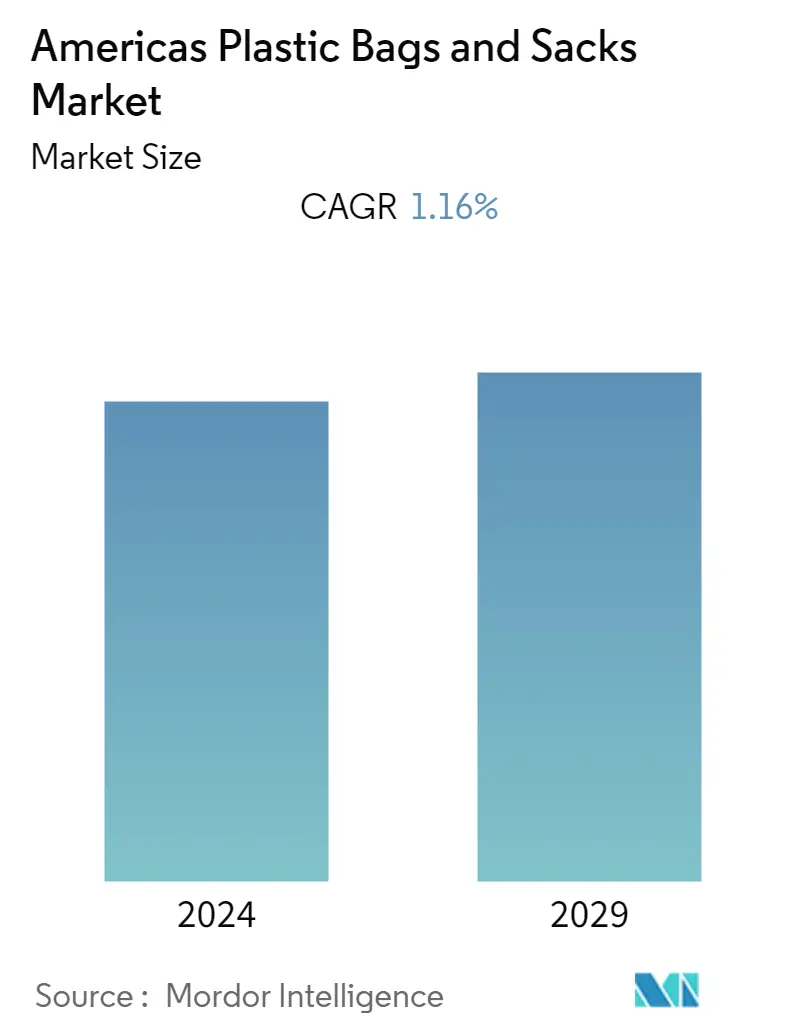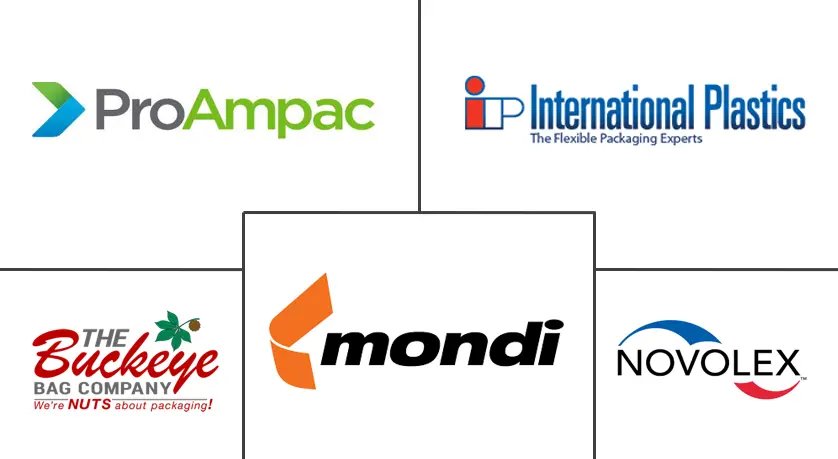Market Size of Americas Plastic Bags and Sacks Industry

| Study Period | 2019 - 2029 |
| Base Year For Estimation | 2023 |
| Forecast Data Period | 2024 - 2029 |
| Historical Data Period | 2019 - 2022 |
| CAGR | 1.16 % |
| Market Concentration | High |
Major Players
*Disclaimer: Major Players sorted in no particular order |
Americas Plastic Bags and Sacks Market Analysis
The Americas Plastic Bags & Sacks market was valued at USD 5.71 billion in 2020. It is expected to reach a value of USD 6.14 billion by 2026, registering a CAGR of 1.16% over the forecast period (2021 - 2026). The COVID-19 pandemic has significantly impacted retail plastic bags sales in the region. The industry has been experiencing slowdowns in the supply chain, primarily owing to the lockdown of factories. According to the US Census Bureau, the retail sale decreased in Apr 2020 and is further expected to fluctuate in 2020. There has been a disruption in the whole supply chain network in the region. However, few stores, such as groceries, supermarkets, among other stores, were allowed to sell daily need products, which are expected to offset the impact to a certain extent.
- According to the Center for Biological Diversity, Americans have been using around 100 billion plastic bags every year, which requires about 12 million barrels of oil to manufacture. The Americans make use of an average of 365 plastic bags per person every year.
- However, according to the United States Environmental Protection Agency, plastics have been a rapidly growing segment of municipal solid waste (MSW). While plastic is found in all significant MSW categories, the containers and packaging category holds the most plastic tonnage. This category includes plastic bags, sacks, and wraps, among another packaging; polyethylene terephthalate bottles and jars; high-density polyethylene (HDPE) natural bottles; among different containers.
- The state legislatures have also taken multiple measures to reduce the prevalence of plastic bags at grocery stores and other businesses. The reduction of this bag can mitigate harmful impacts to the oceans, lakes, rivers, forests, and the wildlife that inhabit them. It can also relieve pressure on the landfills and waste management. While some states have been focusing on implementing effective recycling programs, others have been imposing bans or fees to discourage plastic bags. For instance, in May 2021, the Colorado House decided to ban plastic carryout bags and expanded polystyrene foam food service containers statewide with HB1162.
- Moreover, changing lifestyles and the consequent dependence of consumers on processed, packaged, and precooked food has also been increasing the demand for plastic packaging solutions. The advent of the supermarket culture has also altered the shopping landscape and has impacted the need for plastic bags, especially in the retail sector. The altering lifestyle of people has resulted in the shift from home-cooked to ready-to-eat products.
- In July 2020, Walmart, Target, and CVS Health announced that they collaborated with the Kroger Co. and Walgreens in the 'Consortium to Re-invent the Retail Bag,' an organization founded to test single-use plastic shopping bags options, which mass retailers across the region now use. The retailers teamed up with The Center for the Circular Economy at Closed Loop Partners and have collectively pledged more than USD 15 million to launch the 'Beyond the Bag' Initiative.
- Further, Governments across the region have responded to public concerns regarding packaging waste, especially plastic packaging waste that includes bags and sacks. They are implementing regulations to both minimize environmental waste and improve waste management processes. In the United States, 16 states have enacted statewide laws around packaging waste, which tend to target single-use plastics.
Americas Plastic Bags and Sacks Industry Segmentation
The study tracks the demand for Plastic bags and sacks, also termed Polybags, based on their end-use market and material type. The study also tracks the current regulatory guidelines and practices in the Americas region, covering the United States, Canada, and Latin America (Brazil, Mexico, and others). The growing presence of biodegradable bags is expected to offset the decline partially. Further, the report also covers the analysis of the impact of COVID-19 on the market, the stakeholders, and the same has been considered for the current market estimation and future projections. The market estimation covers the revenue accrued from sales of plastic bags and sacks as listed, offered from the vendors operating in the market.
| By Material Type | ||||||
| ||||||
| Bio-degradable (PLA, PHA, etc.) |
| By Application Type | |
| Consumer and Retail (includes apparel, consumer goods, etc.) | |
| Institutional (includes hospitality and healthcare) | |
| Industrial (includes sacks, etc.) | |
| Other Applications |
| By Geography | ||||
| ||||
| Latin America |
Americas Plastic Bags and Sacks Market Size Summary
The Americas Plastic Bags and Sacks industry is navigating a complex landscape shaped by regulatory changes, consumer behavior shifts, and environmental concerns. The market, characterized by its reliance on high-density polyethylene bags, is experiencing a transition due to increasing restrictions on single-use plastics across various states. This shift is driven by legislative efforts to mitigate environmental impacts, such as ocean and wildlife pollution, and to alleviate pressure on landfills. Retailers are responding by adopting sustainable practices, such as the 'Beyond the Bag' initiative, which aims to explore alternatives to single-use plastic bags. The COVID-19 pandemic further complicated the market dynamics, causing supply chain disruptions and altering consumer shopping habits, with a temporary increase in reliance on single-use bags for safety reasons.
Despite these challenges, the market is poised for growth, fueled by the expanding retail sector and changing consumer lifestyles that favor convenience and packaged goods. Supermarkets and grocery stores remain significant contributors to plastic bag demand, with initiatives to enhance sustainability and reduce plastic waste gaining traction. The industry is also witnessing increased collaboration among major retailers and manufacturers to innovate and implement eco-friendly packaging solutions. As the market evolves, companies are focusing on product innovation and strategic partnerships to maintain competitiveness and address environmental concerns, ensuring a balanced approach to growth and sustainability in the Americas.
Americas Plastic Bags and Sacks Market Size - Table of Contents
-
1. MARKET DYNAMICS
-
1.1 Market Overview
-
1.2 Marker Drivers
-
1.2.1 Growing Unit Sales in Key End-user Markets
-
1.2.2 Advancements in Printing Industry has Enabling Firms to Use Plastic Bags to Promote their Brands
-
-
1.3 Market Challenges
-
1.3.1 Stringent Regulations over the Use of Plastic Bags (particularly the single-use variety has posed a considerable challenge for manufacturers and end-users)
-
-
1.4 Industry Attractiveness - Porter's Five Forces Analysis
-
1.4.1 Threat of New Entrants
-
1.4.2 Bargaining Power of Buyers
-
1.4.3 Bargaining Power of Suppliers
-
1.4.4 Threat of Substitute Products
-
1.4.5 Intensity of Competitive Rivalry
-
-
1.5 Industry Value Chain Analysis
-
1.6 Industry Standards and Regulations
-
1.7 Analysis of the Relative Demand for Various Types of Plastic Bags and Sacks - T-shirt, Trash, Rubble, Woven-based, etc.
-
-
2. AMERICAS PLASTIC BAGS & SACKS MARKET SEGMENTATION
-
2.1 By Material Type
-
2.1.1 Non-Biodegradable
-
2.1.1.1 High Density Polyethylene (HDPE)
-
2.1.1.2 Polystyrene (PS)
-
2.1.1.3 Low Density Polyethylene (LDPE)
-
2.1.1.4 Others
-
-
2.1.2 Bio-degradable (PLA, PHA, etc.)
-
-
2.2 By Application Type
-
2.2.1 Consumer and Retail (includes apparel, consumer goods, etc.)
-
2.2.2 Institutional (includes hospitality and healthcare)
-
2.2.3 Industrial (includes sacks, etc.)
-
2.2.4 Other Applications
-
-
2.3 By Geography
-
2.3.1 North America
-
2.3.1.1 United States
-
2.3.1.2 Canada
-
-
2.3.2 Latin America
-
-
Americas Plastic Bags and Sacks Market Size FAQs
What is the current Americas Plastic Bags and Sacks Market size?
The Americas Plastic Bags and Sacks Market is projected to register a CAGR of 1.16% during the forecast period (2024-2029)
Who are the key players in Americas Plastic Bags and Sacks Market?
ProAmpac LLC , The Buckeye Bag Company, Mondi PLC, Novolex Holdings and International Plastics Inc. are the major companies operating in the Americas Plastic Bags and Sacks Market.

